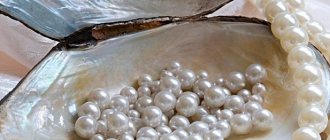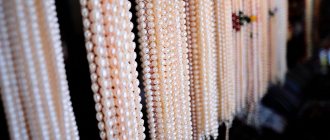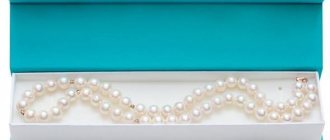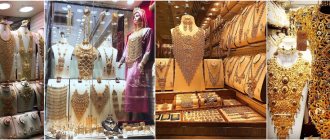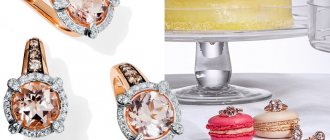Natural pearls are the oldest jeweler's material known to mankind., and one of the unique jewelry, since it does not originate in the bowels of the earth, and the surface of the bead does not require additional processing.
Let's take a closer look at freshwater pearls: what they are and why they are so good.
Types of freshwater pearls
Freshwater pearls are divided into two types - natural and cultured . They are considered natural in both cases, since they are formed naturally.
Jewelry made from freshwater pearls has always been valued. Today, products made from them can be purchased here:
Pearl bracelet
Natural pearls
Natural freshwater pearls are a bead that is formed from a small grain of sand in a mollusk shell without human intervention..
It can be round, oval or irregular in shape. The color is most often milky white, but cream, pink-orange, lilac, brown and champagne shades are also found.
The size of the beads depends on many factors:
- age of the mollusk;
- its habitat;
- type of oyster.
Over time, the mineral becomes less and less due to the aging of both the snail itself and the wear and tear of its shell. Each pearl is unique, and the process of its formation cannot be influenced. Mining natural pearls is a labor-intensive and expensive business, so this method is used extremely rarely.
Cultured pearls
The river cultivated species is grown on special farms. It is found in round, button-shaped, pear-shaped, oval, teardrop-shaped and irregular shapes, but the beads are always neat and even.
The most common color of a cultivated mineral, as in the case of a natural one, is milky mother-of-pearl; coffee, greenish and gray shades are less common.
The size of beads is divided into three types:
- Varietal. Diameter from 5–10 mm. Used in the manufacture of jewelry, it is considered the most expensive due to the complexity and duration of cultivation.
- Beads. Diameter 3–5 mm. It grows in 1.5–2 years.
- Pearl dust. Maximum diameter 3 mm. Mainly used to decorate bags, shoes and clothing.
Education and mining
Sometimes there is something foreign in the body of a freshwater mollusk. This is where the pearl is formed. It usually appears in the area of the valve closing muscle or on the upper part of the body fold (mantle).
Mother of pearl covers the inner wall of the shell. When a foreign particle enters, for example, a grain of sand or an insect larva, the nerve endings of the mollusk become irritated. As a response, the epithelial tissues divide and a special sac appears - a cyst. Next, the mantle secretes nacre, which forms a pearl.
Sometimes a clot of mother-of-pearl appears without a foreign body. It is necessary for the epithelial cells to be inside the mantle. This happens, for example, due to injury or pathology.
In fresh waters - lake and river - most stones are obtained from mollusks of the genera Margaritifera and Dahurinaia. First of all, these are pearl mussels: European, Daurian, Kamchatka. Pearls are also found in toothless and pearled pearls.
Freshwater pearls take three to twelve years to mature. The timing depends on the species, environment, and age of the mollusk. The older he is, the smaller the pearls. River mollusks produce small, irregularly shaped minerals.
In the 19th century, a lot of river pearls were mined in the Russian Empire, especially in the north of the country. Nowadays, minerals of different origins end up in jewelry workshops. They are mined and grown in Russia, China, Germany, Great Britain, and the USA. Cultivation is practiced on farms.
You can try to find a river pearl on your own. But this will take a lot of time and does not guarantee a positive result. The shells are collected from the bottom. A sign that they contain a precious mineral are irregularities or tubercles on the valves.
The history of pearls
Naturally, pearls are formed due to the ingress of small foreign particles into the folds of the mantle - the soft tissue of the oyster. Their constant presence in the shell irritates the mollusk, and its body produces nacre as a protective reaction to the irritant, smoothing out the sharp corners of the foreign body.
In the range from 3 to 12 years, a full-fledged pearl bead is formed from a microscopic grain of sand, perhaps even more than one . A shell can contain up to 12–16 pearls.
The cultivated mineral is obtained by analogy with the natural one. The only difference is that foreign particles are artificially introduced into shells with mollusks located in special nets in the water. This method takes more time, but the good thing about this method is that a person can choose the types, sizes and age of oysters at his own discretion to obtain pearls of the required parameters.
This is interesting! Sometimes pearl beads grow to the shell.
In this case, they become unsuitable for use in jewelry, regardless of the size of the mineral and the uniqueness of its color.
Buying: river pearls versus sea pearls.
Because the nacre layer of river pearls is thicker, they are more durable than sea pearls, which are more vulnerable to wear and tear and are also more prone to chipping.
Marine ones, on the other hand, are shinier and have a more round shape.
As you can see, when choosing between these two varieties, you need to weigh appearance versus durability and decide what trade-off to make.
Finally, if you can find river specimens that have been raised using modern methods, you will find that their luster and shape often match those of the sea, but at a more reasonable price.
Distinctive features of freshwater and sea pearls
When choosing pearl jewelry, the question arises of how to distinguish sea pearls from river pearls and which one is better to purchase. Comparing these two types will help you decide.
Form
A sea mineral is always perfectly smooth and round, while a river mineral has a wide variety of shapes.
Size
Beads taken from the sea are larger than freshwater beads.
Shine
The sea pearl shines brighter. The river one has calm, muted shimmers of mother-of-pearl.
Color
The color palette of sea minerals is wider: black and pink beads are predominantly sea.
Durability
Freshwater pearls are more durable because they have stronger and deeper nacre layers. A sea pearl wears out and tarnishes much faster - its mother-of-pearl coating is only about 0.5-6 mm thick.
Price
Sea pearls are several times more expensive than river pearls. This is explained by the fact that a dozen beads can form at once in a freshwater shell, but only 1–3 in a sea shell.
Previously, the cultivated freshwater mineral was allowed to mature for less than 2 years, which negatively affected the shape of the beads, their size and the thickness of the mother-of-pearl layer. Nowadays the cultivation period for pearls reaches 6 years, thanks to which they have achieved almost complete identity of freshwater pearls with sea pearls.
Mining freshwater pearls
Freshwater pearls are mined in China, Russia, Germany, and the USA. About 99% of pearls that go on sale are cultured. The leader in the production of mother-of-pearl beads is China.
The place where pearls are grown can be not only a river or lake, but also rice plantations flooded with water that are no longer used for their intended purpose. These fields have a suitable microclimate for the rapid reproduction and cultivation of mother-of-pearl beads.
Freshwater pearls do not have a nucleus, as they are created using a nuclear-free method. To do this, foreign tissue is introduced into the skin fold of the mollusk’s body, which begins to become covered with balls of mother-of-pearl. The layer of mother-of-pearl in freshwater stones is thicker than in sea stones.
The nuclear-free method allows you to insert several implants into the shell at once to grow several pearls. About 12–16 beads can form simultaneously in one mollusk. During growth, mother-of-pearl beads must be periodically turned over so that their shape is as close as possible to the spherical one, which is considered the standard.
This is interesting! There is another technology for creating freshwater pearls, which is called “Mabe pearls”. To implement it, a plastic ball is inserted into the sink, which is gradually covered with mother-of-pearl. Then a hole is drilled in the ball, and the empty space is filled with epoxy resin. Such a core grows well, and the stones turn out perfectly smooth.
River pearls are not currently mined in a natural way, as this is destructive to nature and costly in material terms. It is much more profitable to create a farm on which, in any case, there will be freshwater pearls.
Do you like freshwater pearls?
Very Not particularly
Pearl mining in Russia
Several centuries ago, there were a lot of world-famous pearls in Russia. It was even enough for export. Both wealthy ladies and queens, as well as ordinary peasant girls, could afford pearl jewelry.
Sundresses and kokoshniks, royal outfits and crowns, wedding dresses and even icons were trimmed with pearls. Mother of pearl beads of various colors were used to make designer jewelry from precious metals.
This is interesting! In the 19th century It was customary to give the bride a handful of pearl beads on a necklace.
Naturally, they didn’t know about scuba diving equipment in those days. Standing on a raft, they looked into the water through a homemade birch bark pipe, and the shells were taken out with a long stick split at the end.
Pearls with rare blue and silver nacre tints, found in the rivers of Karelia, were considered the most valuable . The most common mollusk involved in the formation of minerals is the river pearl mussel Margaritifera margaritifera. In total, about 150 pearl rivers flowed in Russia, but the bulk of production came from the reservoirs of the northern part of the country and the Kola Peninsula.
Nowadays, mother-of-pearl beads are mined in the rivers and lakes of Karelia, in the north of Russia, in particular in Siberia. There are huge shells the size of a man's palm, which stand in colonies in a vertical position at the bottom.
For several decades, a delicate method of obtaining pearls has been used: the oyster, after opening the shell, remains alive, since the valves are only partially opened.
For reference! You can get a pearl yourself. To determine whether there are pearls in river shells, you need to pay attention to the shell itself. In those that have a slight deformation of the valves, various tubercles on the surface, pearls will almost certainly be found.
Interesting Facts
Despite prejudices and superstitions, many brides choose pearls as decoration.
Pearls are a mysterious and mysterious stone. There are many legends, signs, and prejudices associated with him:
- Our Slavic ancestors believed that this was a good wedding gift. The groom gave pearl jewelry to his beloved so that their life together would be happy.
- In some European countries, there is a tradition of tying newlyweds with mother-of-pearl beads right at the wedding. There is a sign associated with it that helps to understand whether the newlyweds will be together. A broken thread promised tears and a break in relationships.
- Nowadays people believe that wearing pearls to a wedding is a bad omen. Supposedly this leads to tears. Apparently, this superstition was facilitated by the fact that pearls were previously called “tears of the sea.”
- Women love jewelry and often receive pearls for their birthdays. Experts are still arguing about this. Some believe that it is not worth giving it for a birthday, so as not to doom your loved one to misfortune, while others say that a better symbol of happiness cannot be found.
- The stone is often recommended to be worn in pairs. It helps maintain harmony in relationships, smooth out misunderstandings, and dispel negative energy in the home. But there is a danger here - the talisman can reduce sexual attraction to a partner, so it is better not to abuse it.
Valuation of freshwater pearls
The cost of pearls is determined by their parameters and methods of cultivation. The most expensive are considered to be natural pearls of spherical shape, rare colors and large size - with a diameter of 10 mm. It is valued because of its long ripening time, which can last for decades - many mollusks simply do not live that long. These are freshwater pearls, the price for 1 piece of which starts from 700 rubles.
The quantity and quality of beads, the type of metal and the presence of other stones in the jewelry directly affect how much the jewelry ultimately costs.
Silver is often used in combination with pearl beads. Such jewelry is not very expensive. The cost of a string of small freshwater pearls ranges from 1000–2000 rubles.
Criteria influencing the assessment
There are several characteristics that allow you to evaluate the quality and affect the cost of freshwater pearls:
- Gloss intensity is one of the most important criteria. The glow should be deep. To evaluate this parameter, you need to carefully examine the pearl under a light source. The best specimens are those in which the boundary between the brightest and darkest areas is clearly defined. Such stones are more expensive.
- Thickness of the mother-of-pearl layer. The longer the pearl is in the mollusk, the thicker its nacre shell. A high-quality bead can retain its beauty for several hundred years. A high-quality specimen can be identified by the following characteristics: the stone is cool and weighty, layers of mother-of-pearl are visible in the drilled hole, the reflection is uniform.
- Surface quality. Natural mother-of-pearl beads may not be perfect, but the fewer defects on its surface, the better quality it is.
- Pearl shape. The most expensive stone is considered to be a perfectly round stone, followed by oval or teardrop-shaped stones. Baroque stones that have an irregular shape have the lowest price.
- Size. The diameter of freshwater pearls ranges from 3 to 11 mm. The larger the circumference of a pea, the more expensive it is.
- Color. The white shade of pearls is considered classic. In addition, beads in cream, white-pink, and light brown shades can be found on sale. You need to evaluate color saturation under a lamp on a light surface.
- The similarity of pearls in decoration. If high-quality pearls were used to create the product, then the degree of their coincidence should be high.
These are the main parameters that will help you choose high-quality freshwater pearls.
Magic properties
Even in ancient times, freshwater pearls were considered to have strong energy; the properties of the stone did not allow vain and self-satisfied people to wear them. Pearl is a purely feminine mineral. It is believed that men who prefer jewelry with pearls become soft and weak-willed due to the fault of mother-of-pearl stone.
Wearing jewelry with this mineral will help the owner in finding happiness in his personal life, longevity, health and fortitude .
Mother-of-pearl beads bring equal benefits to people of all ages, but there are exceptions: it is not recommended to keep pearls at home for families with small children and to wear this stone to people leading a nomadic lifestyle.
WHAT DOES PEARL YIELD DEPEND ON?
Another difference between river pearls and sea pearls is “yield”.
In an oyster at the bottom of the sea, as a rule, only one pearl matures. Whereas in shells from fresh water bodies you can find ten mother-of-pearl beads.
The costs of cultivating ocean pearls are higher and so is their price.
Who is pearl suitable for?
For those who are guided by the choice of gemstones for themselves in accordance with the horoscope, astrologers recommend the following:
- Freshwater pearls are suitable for the water signs of the zodiac - Cancer, Scorpio, Aquarius and Pisces.
- Jewelry with rare black pearls will bring a feeling of peace and tranquility to representatives of the fire elements - Leo and Aries.
Natural freshwater pearls are used to produce a variety of jewelry: strings of pearl beads, which can contain stones of the same or different colors and sizes, earrings, pendants, brooches, etc.
Sets consisting of several types of jewelry in the same style are popular. The river mineral is perfectly complemented by cubic zirconia and diamonds.
Physical and chemical properties
Pearl is an organic mineral. This distinguishes it from gemstones that are mined from the earth. In fact, “tears of the sea” are a product of a mollusk’s protective reaction to an external irritant entering the shell.
Its physical and chemical properties:
- formula - CaCO3;
- hardness - 3-4 on the Mohs scale;
- shine - pearlescent;
- fracture - shell-like;
- transparency - opaque, translucent;
- color - white, silver, gold, cream, pink, brown, blue, green, gray, black;
- density - 2.60-2.78 g/cm³;
- refractive index - 1.52-1.66 (for black - 1.53-1.69);
Pearls come in a variety of colors: white, silver, gold, cream, pink, brown, blue, green, gray and even black. Experts counted more than a hundred shades. The color is influenced not only by the type of mollusk-producers, but also by location and age.
Differences between natural pearls and their imitation
Fake pearls are considered to be plastic jewelry, disguising other stones as pearls and artificial minerals grown without the participation of shellfish. Some details will help you figure out how to distinguish natural pearls from fakes:
- The most obvious evidence of crude imitation is traces of paint near the holes on the bead.
- Fake pearls are noticeably lighter.
- The surface of genuine stone is always cool.
- If you rub two natural beads against each other, no chips or scratches will appear on them.
- The fake is sold at a reduced price.
How to care for pearls
If you wear pearls with proper care, your jewelry will serve you for a very long time. They can even be passed on by inheritance, although esotericists do not welcome these actions. It is believed that the sea talisman absorbs the owner’s negativity and then passes it on to the next owner.
Care instructions:
- Jewelry should be stored separately from other jewelry. The mineral is very fragile, so try to protect it from falls and impacts with other talismans.
- The stone does not like heat and is afraid of high temperatures. Not only the sun, but also the artificial warm climate recreated indoors. So it’s better not to go to the bathhouse with him.
- By the way, cold and humidity can also harm the amulet. Being in such conditions results in a loss of shine for him.
- This is tricky stuff. It is not only fragile, but also does not like to interact with various substances. Perfume, foundation and hairspray can ruin it. Try to prevent jewelry from coming into contact with cosmetics.
To keep your jewelry beautiful, pearls need to be cleaned. Professionals use a weak solution of acetic acid for this. But if you are afraid to take the wrong proportions, you can replace it with a safer soap solution.
Caring for pearl jewelry at home
Like all jewelry, pearls also require a certain amount of care, especially since, although they are considered a precious stone, they are not such in essence and are more vulnerable. To keep delicate pearl beads in their original condition for a long time, it is helpful to know how to clean pearls and how to store them properly.
Cleansing
To maintain the pearlescent glow of pearls, they must be cleaned from time to time. In this case, neither vinegar nor abrasive cleaners will work, as they will only damage the mother-of-pearl layers. It is best to use a soap solution and a soft cloth. You can restore shine to the beads using potato starch or saline solution (1 teaspoon of salt per glass of water). After processing the jewelry, it is allowed to dry and polished thoroughly.
Storage rules
Pearls are stored separately from other jewelry in a box with soft fabric or a special bag made of linen, silk or satin. It is important that the fabric does not stain the mother-of-pearl. High temperatures have a negative impact on the safety of mother-of-pearl beads.
Pearls are kept cool, but if for some reason this is not possible, then place a glass of water next to the place where the jewelry is stored.
Attention! Pearl jewelry should not be stored hanging or in an open space not protected from sunlight.
Jewelry with natural freshwater pearls has long been considered a classic. They are suitable for any outfit and occasion, be it a gala reception or a business meeting. It is for this reason that pearl jewelry will never go out of style.
What kind of stone is Majorca?
The Spanish jewelry company Majorica has discovered and patented an exclusive method for producing imitation real pearls. The composition and formula of the material, produced at an industrial enterprise without the participation of marine life, is kept secret. The company only demonstrates to everyone what Majorca pearls are and how they are made. The process of making the base can be observed in the company store on the island of Mallorca, where the jewelry production and the company's head office are located.
The artificial material is balls of glassy mass. The master makes each pearl by hand by heating a stick of translucent substance. The molten soft mass is wound around a metal rod.
The cooled balls are mounted on a wooden frame and sent to the workshop for finishing. There they are coated with a paste that includes powder made from real pearls and mother-of-pearl. The company also keeps the full composition of this paste secret. Dried pearls, already similar to real ones, are polished with special soft brushes. At the same time, imitation major pearls acquire the luster characteristic of natural stone of the highest quality.
Thanks to modern technologies, Mallorca is painted in a variety of colors: yellow, black, pink. They imitate expensive and rare varieties of natural cultivated stone (blue, for example), and paint the balls in colors unusual for the mineral, applying gold or silver.
Silver ring SL with cubic zirconia and pearls (go to the SUNLIGHT catalogue)
Ready-made pearl beads are strung on strong threads. A piece of jewelry containing Majorca stone can be complemented with Swarovski crystals and metal elements. Ready-made necklaces and bracelets are sold all over the world and are highly valued.
Other ways to imitate pearls
People learned to counterfeit real stones a long time ago. Already in the 15th century, “Roman pearls” were known, which were made from glass balls filled with paraffin. In China, they still use “pearl essence” - an extract of fish scales that has a pearlescent sheen. To fix it on the surface of the glass, the colored balls were baked in muffle furnaces. After applying several layers, the fake pearls were ready.
In the 20th century, the “shell pearl” technology appeared: beads were milled from a thick mother-of-pearl layer of shells, and they were coated with varnish to add shine. The imitation made from natural material was relatively cheap, and faux pearl beads became fashionable on the American continent.
Currently, in addition to imitation, improvement of low-quality natural pearls is also used. For this purpose, tinting and irradiation are used. Cheap yellow pearls can be turned into more valuable brown and dark ones (petrol, eggplant and various shades of blue). Very valuable and rare black pearls can be obtained by irradiating ordinary low-quality stones with X-rays or neutrons. The demand for such varieties is much higher, and it is more profitable for jewelry manufacturers to sell goods at a higher price.
How to identify cultured pearls
Cultured pearls are not literally fake unless they try to sell them at the price of a wild stone. It is created under artificial conditions, under which the mollusk actively produces nacre. To do this, a foreign body is placed in the shell, performing the function of a seed nucleus.
X-ray
X-rays can help distinguish natural pearls from cultured ones. With its help you can examine the structure of the mineral. The picture shows the presence of a core, density and number of layers. The disadvantage of this method is that as a result of X-ray irradiation, the jewelry may change color.
Bright light
A safer way to identify cultured pearls is to view the stone in a bright light. It is convenient to use an ovoscope for this. By shining a bright light through the bead, you can see the presence of a seed nucleus in it.
Checking the barcode of pearls
ATTENTION! The correct barcode is not a 100% guarantee of the originality of the pearl. At the same time, an incorrect barcode is a clear sign of counterfeit.
To check the authenticity of pearls, enter the numbers in the field and click the “Check” button. If the barcode is correct, then it is recommended to also check the country of origin.
Important! This service checks the relevance and correctness of the applied barcode, but does not guarantee that the entered code is not taken from another product and the jewelry being checked is not counterfeit.
